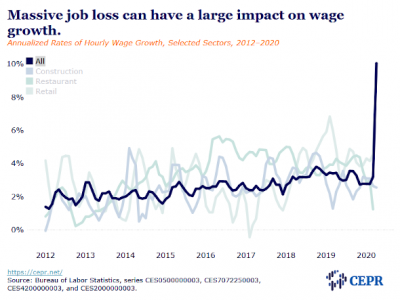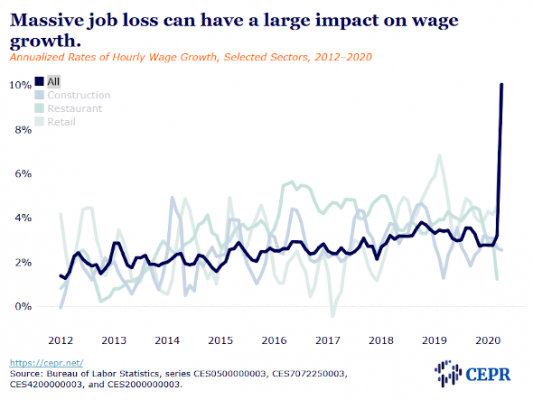Analysis by Dean Baker – Center for Economic Policy and Research
Temporary layoffs make up 78.3 percent of unemployment.
As expected, the April jobs report showed a catastrophic hit to the labor market stemming from the pandemic. The economy lost another 20,500,000 jobs in April after losing 870,000 jobs in March. This is an order of magnitude higher than any previous two-month decline on record.
The unemployment rate jumped to 14.7 percent, up 11.2 percentage points from what had been a 50-year low of 3.5 percent in February. The employment-to-population (EPOP) ratio was down 9.8 percentage points over this period, as 25.4 million fewer people report being employed in April than in February.
There is some good news in this horrible picture: 78.3 percent of the unemployed are temporary layoffs, meaning they expect to get their old jobs back. That won’t always be the case, but this is much better than the opposite.
In the same vein, people working part-time for economic reasons are up by 6.6 million since February. This means that many employers are keeping workers on with reduced hours rather than laying them off. Although, this doesn’t completely square with the fact that the average workweek is only down by 0.2 hours, less than 1.0 percent.
One item worth noting in this report is that unemployment has actually risen slightly more for whites since February than for blacks, with the unemployment rate for whites up 11.1 percentage points compared to 10.9 percentage points for blacks.
This reverses the usual pattern in a downturn where black workers typically see much sharper rises in their unemployment rate, although this is probably not a positive story. In this pandemic, black workers are more likely to be classified as essential, which means they keep their jobs but are risking their health.
In the same vein, the unemployment rate for college grads has risen by only 6.5 percentage points since February compared to 13.7 percentage points for those with just a high school degree, and 15.5 percentage points for those without a high school degree. This reflects who is able to work from home in this crisis.
Job loss was spread across industries with every major sector seeing job declines that would be viewed as catastrophic in a more normal month. Most of the industries seeing sharpest hits are not surprises.
- Restaurants lost 5,919,000 jobs since February, 48.1 percent of employment in the sector.
- Hotels lost 885,000 jobs, 42.3 percent of total employment.
- Airlines shed 139,000 jobs, 27.2 percent of total employment.
- Retail lost 2,152,000 jobs, 13.7 percent of employment in the sector.
- Interestingly, non-store retailers also lost jobs, with employment down by 6.1 percent since February. This presumably reflects safety considerations offsetting the effect of an increase in demand.
- Health care saw another sharp drop in employment with jobs in the sector now down by 1,475 (8.9 percent) since February. This reflects a huge drop in elective procedures and check-ups. Employment in dentists’ offices is down 53.3 percent since February.
- Manufacturing and construction have shed 1,364,000 (10.6 percent) and 1,008,000 (13.2 percent) jobs, respectively. Mining has lost 52,800 jobs, 8.0 percent of employment, but this figure is certain to increase if oil prices stay low.
- On the other side, finance has lost just 265,000 jobs or 3.0 percent of employment.
- Waste services lost 13,000 jobs or 2.8 percent of employment. Workers in finance can work at home, workers in waste services are essential workers.
One perverse effect of this massive job loss was a huge jump in wages. The average hourly wage rose by 4.7 percent in April. This is due to both the disproportionate job loss in lower-paying sectors and also the shift within each sector as the higher paid workers are the ones most likely to keep their jobs. The average hourly wage in retail rose by 4.4 percent. In leisure and hospitality, it rose by 6.8 percent.







